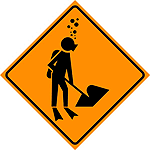|
| |

|
|
| < Prev. month |
Next month > |

|
This page under construction.
Here are some of the topics that will be covered in this chapter. More text and images will eventually be added to this section. Thank you for your patience.
|
- Less consistent nutrients available for phytoplankton growth; following less frequent upwelling events, diatom blooms use up the new nutrients quickly, before the next upwelling event begins.
- As upwelling events become somewhat less frequent, a new species of diatom, Chaetoceros radicans, comes to the fore. This species, in particular, seems to bloom during the relaxation at the end of upwelling events.
- Diatom blooms become concentrated closer to shore, where there is still plenty of iron; phytoplankton grazers are also concentrated nearer shore.
- Picoplankton become more numerous, in part because they need less iron the diatoms; picoplankton populations increase rapidly, but are usually kept in check by abundant grazers.
- Zooplankton reach peak abundance within Monterey Bay. Krill become very numerous within bay, especially along edge of Monterey Canyon.
- In deep water, Poeobius worms reach peak abundance (June-Aug) feeding on diatom debris sinking down from above.
- Krill (esp. Euphausia pacifica and Thysanoessa spinifera ) begin to reach maturity (fully grown to about ¾ inch long). Also form extremely dense patches (required for blue whale feeding).
- Nanomia siphonophore populations peak. They are common all year but multiply in summer, when they feed on krill.
- Anchovies become numerous, congregating in Monterey Bay in June/July, after moving up the coast from Southern California. They are accompanied by large numbers of predators, who also migrate up from the south, including California sea lions, elegant terns, pelicans, and Heerman's gulls.
- As juvenile rockfish begin to settle into the kelp beds and to the seafloor, predators such as salmon, murres, and other seabirds switch from feeding on juvenile rockfish to feeding on anchovies or krill.
- King salmon move toward shore, gathering off the mouth of San Francisco Bay to eat anchovies. The salmon will continue to feed in this area until the first winter rains, when they will head up stream to spawn.

|
|
